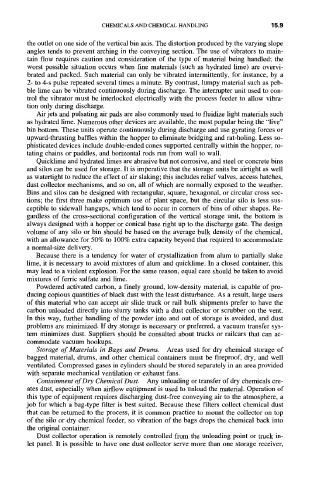Page 499 -
P. 499
CHEMICALS AND CHEMICAL HANDLING ] 5.9
the outlet on one side of the vertical bin axis. The distortion produced by the varying slope
angles tends to prevent arching in the conveying section. The use of vibrators to main-
tain flow requires caution and consideration of the type of material being handled; the
worst possible situation occurs when fine materials (such as hydrated lime) are overvi-
brated and packed. Such material can only be vibrated intermittently, for instance, by a
2- to 4-s pulse repeated several times a minute. By contrast, lumpy material such as peb-
ble lime can be vibrated continuously during discharge. The interrupter unit used to con-
trol the vibrator must be interlocked electrically with the process feeder to allow vibra-
tion only during discharge.
Air jets and pulsating air pads are also commonly used to fluidize light materials such
as hydrated lime. Numerous other devices are available, the most popular being the "live"
bin bottom. These units operate continuously during discharge and use gyrating forces or
upward-thrusting baffles within the hopper to eliminate bridging and rat-holing. Less so-
phisticated devices include double-ended cones supported centrally within the hopper, ro-
tating chains or paddles, and horizontal rods run from wall to wall.
Quicklime and hydrated limes are abrasive but not corrosive, and steel or concrete bins
and silos can be used for storage. It is imperative that the storage units be airtight as well
as watertight to reduce the effect of air slaking; this includes relief valves, access hatches,
dust collector mechanisms, and so on, all of which are normally exposed to the weather.
Bins and silos can be designed with rectangular, square, hexagonal, or circular cross sec-
tions; the first three make optimum use of plant space, but the circular silo is less sus-
ceptible to sidewall hangups, which tend to occur in corners of bins of other shapes. Re-
gardless of the cross-sectional configuration of the vertical storage unit, the bottom is
always designed with a hopper or conical base right up to the discharge gate. The design
volume of any silo or bin should be based on the average bulk density of the chemical,
with an allowance for 50% to 100% extra capacity beyond that required to accommodate
a normal-size delivery.
Because there is a tendency for water of crystallization from alum to partially slake
lime, it is necessary to avoid mixtures of alum and quicklime. In a closed container, this
may lead to a violent explosion. For the same reason, equal care should be taken to avoid
mixtures of ferric sulfate and lime.
Powdered activated carbon, a finely ground, low-density material, is capable of pro-
ducing copious quantities of black dust with the least disturbance. As a result, large users
of this material who can accept air slide truck or rail bulk shipments prefer to have the
carbon unloaded directly into slurry tanks with a dust collector or scrubber on the vent.
In this way, further handling of the powder into and out of storage is avoided, and dust
problems are minimized. If dry storage is necessary or preferred, a vacuum transfer sys-
tem minimizes dust. Suppliers should be consulted about trucks or railcars that can ac-
commodate vacuum hookups.
Storage of Materials in Bags and Drums. Areas used for dry chemical storage of
bagged material, drums, and other chemical containers must be fireproof, dry, and well
ventilated. Compressed gases in cylinders should be stored separately in an area provided
with separate mechanical ventilation or exhaust fans.
Containment of Dry Chemical Dust. Any unloading or transfer of dry chemicals cre-
ates dust, especially when airflow equipment is used to unload the material. Operation of
this type of equipment requires discharging dust-free conveying air to the atmosphere, a
job for which a bag-type filter is best suited. Because these filters collect chemical dust
that can be returned to the process, it is common practice to mount the collector on top
of the silo or dry chemical feeder, so vibration of the bags drops the chemical back into
the original container.
Dust collector operation is remotely controlled from the unloading point or truck in-
let panel. It is possible to have one dust collector serve more than one storage receiver,

